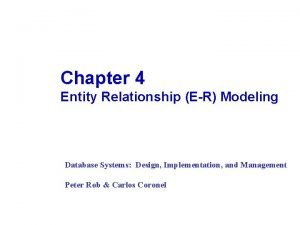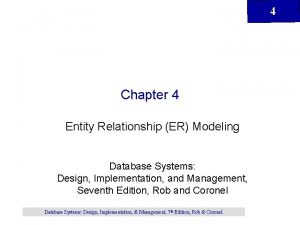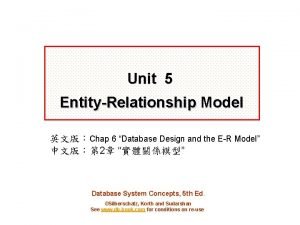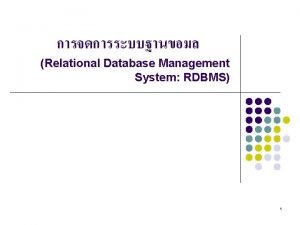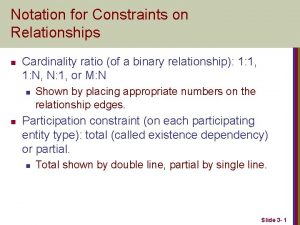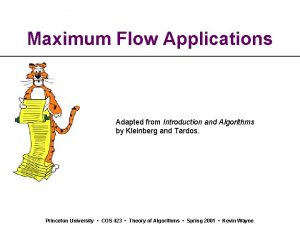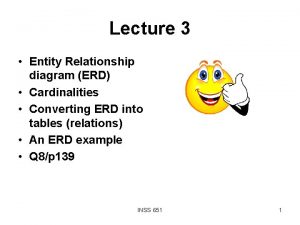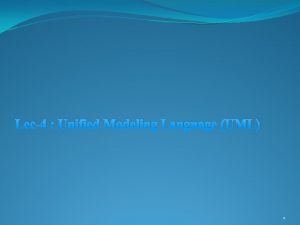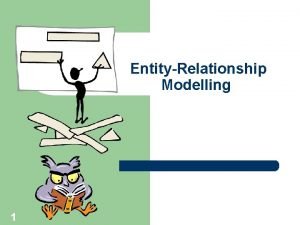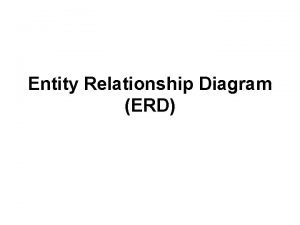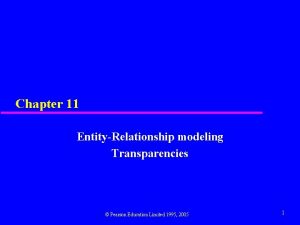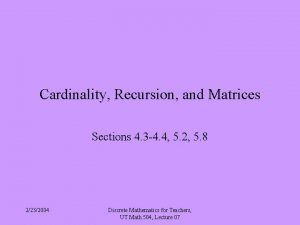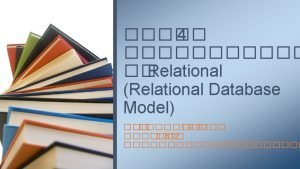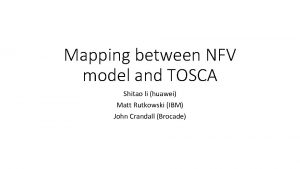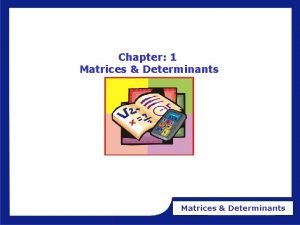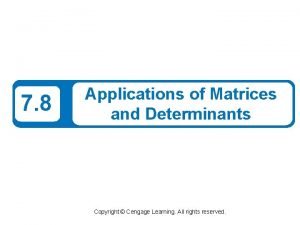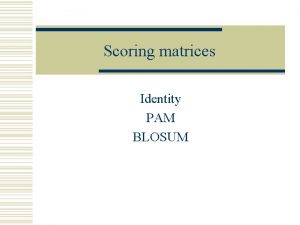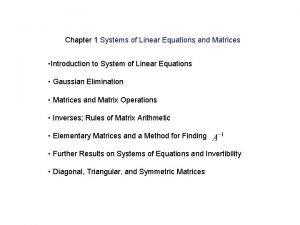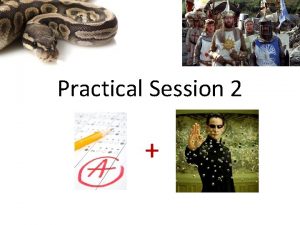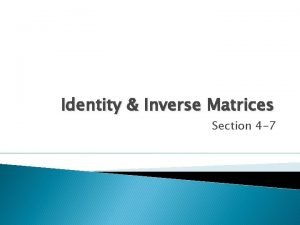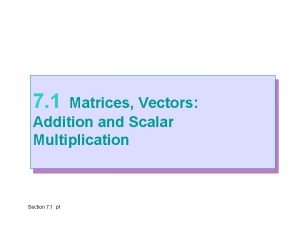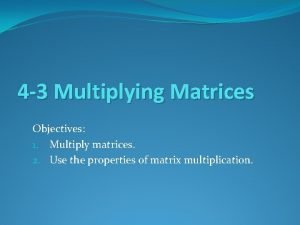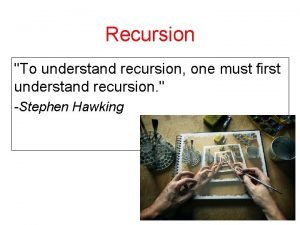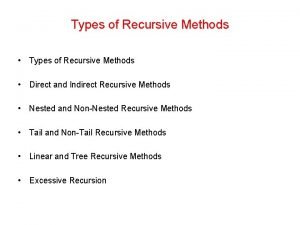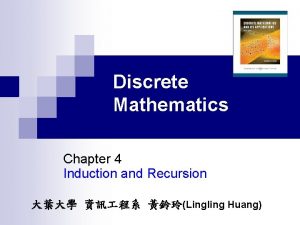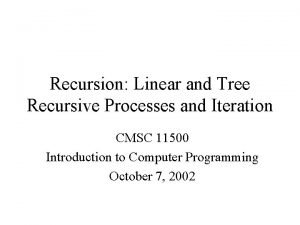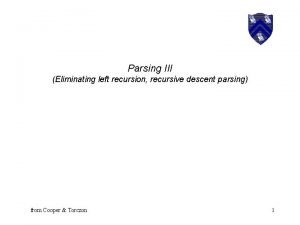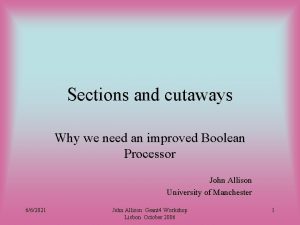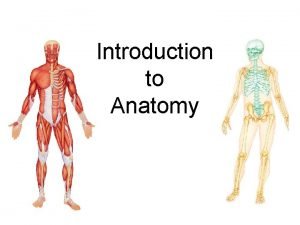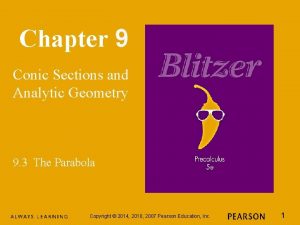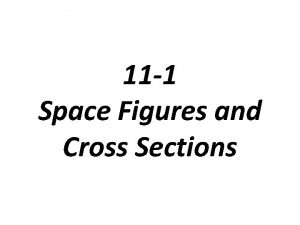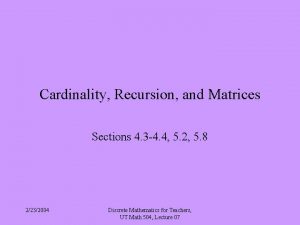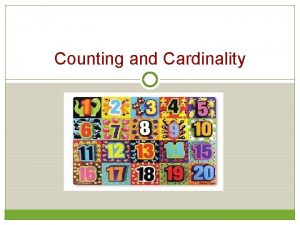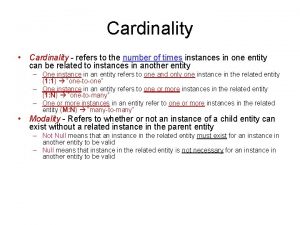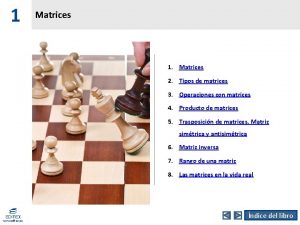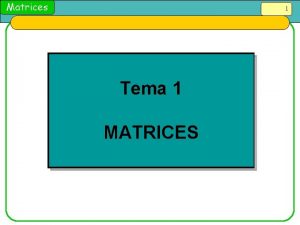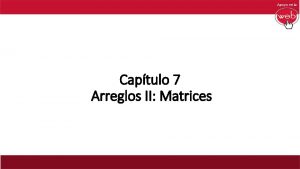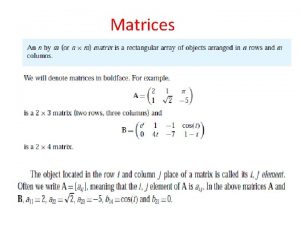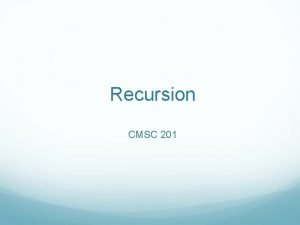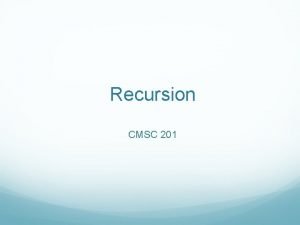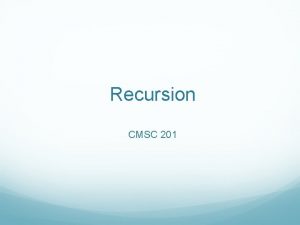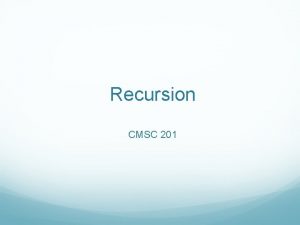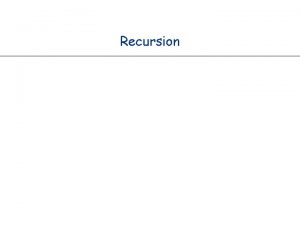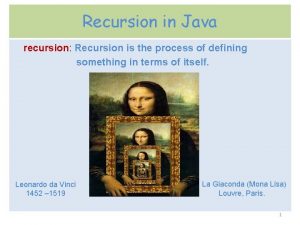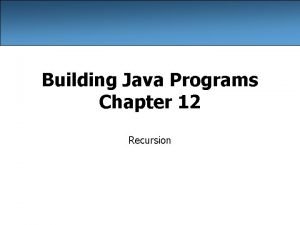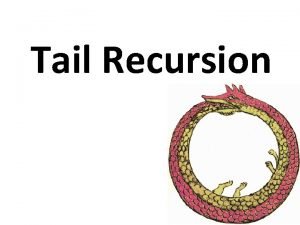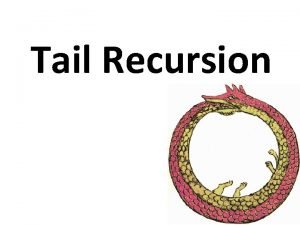Cardinality Recursion and Matrices Sections 4 3 4














![More advanced theorems • The set of real numbers [0, 1] is uncountable (4. More advanced theorems • The set of real numbers [0, 1] is uncountable (4.](https://slidetodoc.com/presentation_image_h/e3d999cd287bf229bc8e575992fddfac/image-15.jpg)






































- Slides: 53

Cardinality, Recursion, and Matrices Sections 4. 3 4. 4, 5. 2, 5. 8 2/23/2004 Discrete Mathematics for Teachers, UT Math 504, Lecture 07

Cardinality • It was the work of Georg Cantor (1845– 1918) to establish the field of set theory and to discover that infinite sets can have different sizes. His work was controversial in the beginning but quickly became a foundation of modern mathematics. Cardinality is the general term for the size of a set, whether finite or infinite. 2/23/2004 Discrete Mathematics for Teachers, UT Math 504, Lecture 07 2

Definition for finite sets • The cardinality of a finite set is simply the number of elements in the set. For instance the cardinality of {a, b, c} is 3 and the cardinality of the empty set is 0. More formally the set A has cardinality n (for nonnegative integer n) if there is a bijection (one to one correspondence) between the set {1, 2, 3, …, n} and the set A. Formally then we define the bijection f: {1, 2, 3}→{a, b, c} by f(1)=a, f(2)=b, and f(3)=c, thereby proving {a, b, c} has cardinality 3. 2/23/2004 Discrete Mathematics for Teachers, UT Math 504, Lecture 07 3

Definition for finite sets • Although our book saves the notation for later, we denote the cardinality of the set A by |A|. This looks like “absolute value” and it measures the size of a set, just as absolute value measures the magnitude of a real number. Another useful notation that does not appear in our book is to let [n] be the set {1, 2, 3, …n} with [0]=∅. Then we can state that |A|=n if there is a bijection f: [n]→A. 2/23/2004 Discrete Mathematics for Teachers, UT Math 504, Lecture 07 4

Definition of countable • An infinite set A is countably infinite if there is a bijection f: ℙ→A, where ℙ is the set of positive integers. That is ℙ={1, 2, 3, …}. • A set is countable if it finite or countably infinite. A synonym for countable is denumerable. Infinite sets that are not countable are uncountable or, less frequently, nondenumerable. 2/23/2004 Discrete Mathematics for Teachers, UT Math 504, Lecture 07 5

Elementary Theorems • The cardinality of the disjoint union of finite sets is the sum of the cardinalities (4. 45 a). That is, suppose |A|=m and |B|=n for nonnegative integers m and n and disjoint sets A and B. Then |A∪B|=m+n. Proof. There exist bijections f: [m]→A and g: [n]→B. Define a function h: [m+n]→(A∪B) by h(x)=f(x) if 1≤x≤m and h(x)=g(x–m) if m+1≤x≤m+n. It is tedious but not hard to show that f is a bijection. The following picture makes the situation clear. 2/23/2004 Discrete Mathematics for Teachers, UT Math 504, Lecture 07 6

1 2 3 … m 1 2 3 … n f g a 1 a 2 a 3 … am b 1 b 2 b 3 … bn h 1 2 3 … m m+1 m+2 m+3 … m+n 2/23/2004 Discrete Mathematics for Teachers, UT Math 504, Lecture 07 7

Elementary Theorems • The disjoint union of countably infinite sets is countably infinite (4. 45 b). That is, if A and B are countably infinite and disjoint, then A∪B is countably infinite. Proof: The book gives a formal proof. The following picture shows the idea. a 1 a 2 a 3 a 4 … 1 2 3 4 5 6 7 8 … b 1 b 2 b 3 b 4 … 2/23/2004 Discrete Mathematics for Teachers, UT Math 504, Lecture 07 8

Elementary Theorems • The disjoint union of countable sets is countable (4. 45 c). This says that if disjoint sets A and B are finite or countably infinite their union is finite our countably infinite. We have already proved the cases in which both sets are finite or both sets are infinite. If one is finite and the other infinite, we can modify the proof of 4. 45 a to show the union is countably infinite, which is what the book does. 2/23/2004 Discrete Mathematics for Teachers, UT Math 504, Lecture 07 9

Elementary Theorems • The sets ℕ and ℤ are countable. (4. 46) The proof for ℕ is problem #7 in the book. Now let A={– 1, – 2, – 3, …} be the set of negative integers. It is obvious that the function f: ℙ→A by f(n)=–n is a bijection, so A is countable. Since A and ℙ are disjoint and their union is ℤ, then by theorem 4. 45 b, the set ℤ is countably infinite. Visually it is obvious one can define a bijection from ℙ to ℤ as follows. – 3 – 2 – 1 0 1 2 3 … 2/23/2004 Discrete Mathematics for Teachers, UT Math 504, Lecture 07 10

More advanced theorems • I have assigned no homework from section 4. 4, but some of the results there are standard background for modern mathematicians. Without belaboring the results and proofs, I want to give you a guided tour of what is most important. 2/23/2004 Discrete Mathematics for Teachers, UT Math 504, Lecture 07 11

More advanced theorems • Subsets of countable sets are countable (4. 47). This intuitive result is tedious to prove with our definition of countable. Some books define a countable set to be one that can be placed in one to one correspondence with a subset of the positive integers. This is equivalent to our definition and makes the proof of 4. 47 easy. • The Cartesian product of two countable sets is countable (4. 48). This is a standard result that you should know. Intuitively the Cartesian product of sets seems much larger than the sets themselves. For instance, the Cartesian product of [n] with itself has n 2 elements. But for infinite sets, the Cartesian product of countable set has the same cardinality as the set itself. 2/23/2004 Discrete Mathematics for Teachers, UT Math 504, Lecture 07 12

More advanced theorems • The set of positive rational numbers is countable (4. 49). This is an astonishing result that follows immediately from 4. 48. Whether you think of rational numbers as fractions or decimal expansions (terminating and repeating decimals), it feels like there are many more of them than of the integers. In particular there are infinitely many between each integer and the next. Nevertheless the rational number form only a countable set. This holds true even if we include the negative rational numbers. 2/23/2004 Discrete Mathematics for Teachers, UT Math 504, Lecture 07 13

More advanced theorems • The union of countable sets is countable (4. 50) This theorem generalizes 4. 45 b to sets that are not necessarily disjoint. 2/23/2004 Discrete Mathematics for Teachers, UT Math 504, Lecture 07 14
![More advanced theorems The set of real numbers 0 1 is uncountable 4 More advanced theorems • The set of real numbers [0, 1] is uncountable (4.](https://slidetodoc.com/presentation_image_h/e3d999cd287bf229bc8e575992fddfac/image-15.jpg)
More advanced theorems • The set of real numbers [0, 1] is uncountable (4. 51) Finally we get a set that is uncountable. This proof is the standard, classical proof and is the standard example of a diagonalization argument. We assume the reals in [0, 1] are countable and form an infinite list of them, written out in their infinite decimal expansions. We then construct a rational number in [0, 1] that differs from the first number in the first decimal place, from the second number in the second decimal place, etc (these digits lie on the diagonal of the infinite array of numbers at the bottom of p. 159). This contradicts our assumption. Please read the book’s proof carefully; every mathematician should know this proof. 2/23/2004 Discrete Mathematics for Teachers, UT Math 504, Lecture 07 15

More advanced theorems • The set of real numbers ℝ is uncountable (4. 52). Otherwise its subset (0, 1) would be countable. The real numbers are the most important uncountable set. We might be hard pressed to come up with other examples of uncountable sets, but the following result gives us as many as we might want. • There is no bijection from a set to its power set. Remember that the power set is the collection of all subsets of the set. So, for instance, the collection of all subsets of ℙ is not countable. The collection of all subsets of (0, 1) is not countable. Etc. 2/23/2004 Discrete Mathematics for Teachers, UT Math 504, Lecture 07 16

Sets with the Same Cardinality • The standard symbol for the cardinality of ℙ is א 0, which is read “aleph nought. ” Aleph is a letter of the Hebrew alphabet. This is the smallest infinite cardinal. The next are א 1 , א 2 etc. Thus the beginning of the list of cardinal numbers looks like 0, 1, 2, 3, …, א 0 , א 1 , א 2…. That is, it is an infinite list followed by more infinite lists. It is standard to denote the cardinality of ℝ by c (for continuum). We know that c is greater than א 0, but it is unknown whether c= א 1. This proposition (that c= א 1) is called the continuum hypothesis. It was shown in the 20 th century to be independent of the axioms of set theory. That means that it does not contradict them nor can it be proved from them. I believe this gives it a status the same as that of the parallel postulate in geometry: you can accept it or deny it and get a consistent axiomatic system either way. 2/23/2004 Discrete Mathematics for Teachers, UT Math 504, Lecture 07 17

Sets with the Same Cardinality • We say that two sets have the same cardinality if there exists a bijection between them. 2/23/2004 Discrete Mathematics for Teachers, UT Math 504, Lecture 07 18

Theorems on Cardinality • The remainder of the section is mostly obscure. The two results worth noting are the following: • (4. 58) If A and B are sets and there exist injections f: A→B and g: B→A, then A and B have the same cardinality. This is sometimes easier than finding a bijection between A and B. For instance, you can map ℤ to 2ℤ (the even integers) by mapping n to 2 n, and you can map 2ℤ to ℤ by mapping n to (1/2)n. Both maps are injections, so |ℤ|=|2ℤ|. 2/23/2004 Discrete Mathematics for Teachers, UT Math 504, Lecture 07 19

Theorems on Cardinality • (4. 59) There is no bijection between a finite set and a proper subset of that set. This is not actually what theorem says, but it is probably the part of theorem that is actually useful. Note that this theorem fails for infinite sets. For instance 2ℤ is a proper subset of ℤ, but there is an obvious bijection between them, as described above. 2/23/2004 Discrete Mathematics for Teachers, UT Math 504, Lecture 07 20

Recursion • Definition/description of recursive functions (induction backwards): • Suppose we want to define a function f: ℕ→ℤ where ℕ is the set of nonnegative integers. Suppose we define f(0) and we explain how to define f(n+1) whenever we know what f(n) is, for n∈ℕ. Then by induction we have defined the function f for all n∈ℕ. This way of defining a function is called a recursive definition. It corresponds to weak induction. There is also a version corresponding to strong induction in which we define f(n+1) on the assumption we already know f(0), f(1), …f(n). 2/23/2004 Discrete Mathematics for Teachers, UT Math 504, Lecture 07 21

Examples: Factorial & Fibonacci • Factorial: Define a function !: ℕ→ℕ by 0!=1 and (n+1)!=(n+1)(n!). Using this definition with n=4, we get 5!=5(4!)=5(4)(3)(2!)=5(4)(3)(2)(1!) =5(4)(3)(2)(1)(0!)=5(4)(3)(2)(1)(1)=120. Note that this is equivalent to the usual definition of factorials. • Fibonacci sequence: We define a function Fib: ℙ→ℙ Fib(1)=Fib(2)=1, and F(n+1)=Fib(n)+Fib(n 1) for n≥ 1. Then Fib(2)=Fib(1)+Fib(0)=1+1=2. Fib(3)=2+1=3. Fib(4)=3+2=5, etc. This makes it possible to compute Fib(n) for modest values of n quite easily. There is, in fact, a formula for Fib(n), but it is hard to use and remember. For many purposes the recursive definition is much more useful. 2/23/2004 Discrete Mathematics for Teachers, UT Math 504, Lecture 07 22

Examples: Catalan Numbers • The Catalan number Cat(n) counts the number of different ways to insert n sets of parentheses into a product of n+1 factors. For instance Cat(2)=2 since there are only two ways to put parentheses around three factors: ((ab)c) and (a(bc)). The book gives a formula for Cat(n), gives a recursive definition, and then gives a proof by induction that they two are equal. It is a nice example of how natural it is to prove the equivalence of formulas and recursive definitions by induction. It gives, however, no intuition about where the formula and recursive definition come from. We will see them more meaningfully in section 12. 2. 2/23/2004 Discrete Mathematics for Teachers, UT Math 504, Lecture 07 23

Examples: Catalan Numbers • A more meaningful derivation of the Catalan numbers begins with noting that Cat(0)=1. Now suppose we know Cat(0), Cat(1), …, Cat(n) and we wish to find Cat(n+1), the number of ways to put parentheses around n+2 factors. Of course the final pair of parenthesis always goes around the whole product, so there is only once choice for it. On the other hand there are n+1 multiplications, and one of them, say the kth one, must be computed last. The final pair of parentheses corresponds to performing this kth multiplication. There are k factors before it and n–k+2 factors after it, so there are Cat(k 1) ways to parenthesize the first k factors and Cat(n k+1) ways to parenthesis the remaining n–k+2 factors. The total, then, is the sum of the products Cat(k– 1)Cat(n–k+1) for k=1, …, n+1. 2/23/2004 Discrete Mathematics for Teachers, UT Math 504, Lecture 07 24

Examples: Catalan Numbers • Thus Cat(1)=Cat(0)=1(1)=1. Cat(2)=Cat(0)Cat(1)+Cat(1)Cat(0)=1+1=2. Cat(3)=Cat(0)Cat(2)+Cat(1)+Cat(2)Cat(0)=1(2) +1(1)+2(1)=5. Cat(4)=1(5)+1(2)+2(1)+5(1)=14, etc. This is reasonably easy to compute and may serve better than the formula in example 5. 6. Certainly it is easier to remember. 2/23/2004 Discrete Mathematics for Teachers, UT Math 504, Lecture 07 25

Examples: Ackermann’s Function • Ackermann’s function is recursive in two variables. As I recall Ack(n, n)=n^n^n^…^n, where ^ indicates exponentiation and there are n n’s in the expression. That is Ack(2, 2)=2^2, Ack(3, 3)=3^3^3, etc. It is a function of some importance to theory of recursive functions, but it will not interest us. 2/23/2004 Discrete Mathematics for Teachers, UT Math 504, Lecture 07 26

Examples: Binomial Coefficients • A more common and useful recursive function of two variables is the binomial coefficients. If C(n, k) is the number of subsets of size k of a set of size n, say [n], then it is easy to see that C(n, 0)=1 for all n, C(n, n)=1 for all n, and C(n, k)=C(n– 1, k)+C(n– 1, k– 1) for 0≤k≤n. This is a recursive definition, and it produces the familiar Pascal’s Triangle. 2/23/2004 Discrete Mathematics for Teachers, UT Math 504, Lecture 07 27

Examples: Miscellaneous • Annuities: The treatment of the value of an annuity seems gratuitous rather than natural. Read it if you like, but it is not crucial for us. • Tower of Hanoi: This is an attractive problem with a recursive solution. I encourage you to read it, but we will not be concerned with it for class. 2/23/2004 Discrete Mathematics for Teachers, UT Math 504, Lecture 07 28

Solving recursive functions • Sometimes we would like to convert a recursive definition into an equivalent formula for a function. There are formal procedures for doing this, but they are beyond the scope of this course (take the UT senior combinatorics course for more information). The book takes the informal approach of calculating a few values, looking for a pattern, guessing a formula, and then showing that the guessed formula satisfied the recursive definition. By induction this proves that the formula and the recursive definition yield the same values. The book calls this solving the recursive function. 2/23/2004 Discrete Mathematics for Teachers, UT Math 504, Lecture 07 29

Solving recursive functions • Examples: Examples 5. 9 and 5. 10 show straightforward applications of this approach to simple formulas. Example 5. 11 turns the process around and seeks a recursive definition of a function given by a formula. We will look at example 5. 9 briefly to see how the process works. Please glance at 5. 10 on your own, but you may ignore 5. 11 if you wish. 2/23/2004 Discrete Mathematics for Teachers, UT Math 504, Lecture 07 30

Matrices: The Main Idea • Solving a linear equation is one of the easiest jobs in Algebra I. For instance, I can solve 3 x=7 easily by multiplying both sides of the equation by the multiplicative inverse of 3, getting x=3 1(7)=7/3. In general if ax=b, then x=a 1 b as long as a is not 0. 2/23/2004 Discrete Mathematics for Teachers, UT Math 504, Lecture 07 31

Matrices: The Main Idea • Now consider a system of simultaneous linear equations, say • Clearly this system of equations is satisfied by x and y if and only if the following matrix equation is satisfied 2/23/2004 Discrete Mathematics for Teachers, UT Math 504, Lecture 07 32

Matrices: The Main Idea • If we call the first matrix in the preceding equation A, the second X, and the third B, then this equation has the form AX=B, strongly reminiscent of our first equation above. If we could multiply both sides of this equation by the multiplicative inverse of A, if any, then we could also solve this equation getting X=A– 1 B. In short, we are trying to make solving the linear system AX=B look as much like solving the linear equation ax=b as possible. Learning how to justify and do this is the main goal of the section. 2/23/2004 Discrete Mathematics for Teachers, UT Math 504, Lecture 07 33

Matrices: The Main Idea • Along the way the book introduces some standard matrix concepts that are a bit more advanced than what we have seen thus far. Most of these are not crucial for the goal of the section (solving systems of linear equations) and we will not do much with them. They are, however, useful background for you to have. That is, you ought to know that these concepts exist, even if you have to look them up to remember how they work. 2/23/2004 Discrete Mathematics for Teachers, UT Math 504, Lecture 07 34

Defining the Determinant: Submatrix • Let A be an n×n matrix. We will denote by Āij the (n– 1)×(n– 1) matrix gotten by deleting the ith row and jth column from A. (The book puts a line over the whole expression Aij , but I cannot find a simple way to do that in this word processor). • For example, consider the following matrices. We get the second matrix by deleting the first row and second column (marked in red) from the first matrix. 2/23/2004 Discrete Mathematics for Teachers, UT Math 504, Lecture 07 35

Defining the Determinant Recursively • Associated with every square matrix is a number called the determinant. The general definition of the determinant makes it difficult to compute, but for most small matrices it is not as bad as it looks. It is actually a recursive definition. • The determinant of a 1× 1 matrix is simply the sole entry of the matrix. For instance, if A=[5] is a 1× 1 matrix, then det(A)=5. 2/23/2004 Discrete Mathematics for Teachers, UT Math 504, Lecture 07 36

Defining the Determinant Recursively • If A is an n×n matrix for some n≥ 2, then we calculate det(A) by the following procedure – Fix a row or column of A. – For each element in that row or column, find the determinant of the matrix left after deleting that element’s row and column from A. This number is called the minor of the element. That is, if the element is Aij, then its minor is det(Āij). – For each element in that row or column, if the sum of its row and column indices is odd, change the sign of the minor. If the sum of its row and column indices is even, leave the sign of the minor unchanged. The resulting number is called the cofactor of the element. For instance, the cofactor of Aij is (– 1)i+jdet(Āij). – Multiply each element of the row or column by its cofactor and add up the results. This number is the determinant of A. 2/23/2004 Discrete Mathematics for Teachers, UT Math 504, Lecture 07 37

Examples • Let We fix the first row for computing the determinant. In this case A 11=2 and its cofactor is (– 1)1+1 det([7]). Also A 12=3 and its cofactor is (– 1)1+2 det([5]). Thus det(A)=2(7)– 3(5)=– 1. Note that if we had used the other row of a column as the basis for our computation, we would get the same determinant. 2/23/2004 Discrete Mathematics for Teachers, UT Math 504, Lecture 07 38

Examples • From this example it is clear that if then det(A)=ad–bc, which is the product of the elements on the red diagonal minus the product of the elements on the green diagonal. 2/23/2004 Discrete Mathematics for Teachers, UT Math 504, Lecture 07 39

Examples • Now let To find det(A) we can compute along the third column. This will save us work because of the 0 in that column. We will need to find the cofactors corresponding to A 13=5 and A 33=9. • Thus 2/23/2004 Discrete Mathematics for Teachers, UT Math 504, Lecture 07 40

Examples • There is a shortcut for finding the determinant of a 3× 3 matrix A. Multiply together the three numbers on the red line in the first copy of A below. Do the same for the numbers on the green and blue lines. Add these three numbesr. Now repeat the process for the second copy of A and subtract the resulting three products. The result is the determinant of the matrix. Thus we have the result that det(A) =(4)(3)(9)+(– 2)(0)(– 7)+(8)(6)(5)–(– 7)(3)(5)– (4)(6)(0)–(8)(– 2)(9) =108+0+240–(– 105)– 0–(– 144)=597. 2/23/2004 Discrete Mathematics for Teachers, UT Math 504, Lecture 07 41

Larger Matrices • Finding determinants of matrices 4× 4 or larger is a tedious matter by the method we have discussed thus far. We seldom bother with such large matrices in theoretical courses like this one. In courses on numerical mathematics and in real life, however, much larger matrices arise and other approaches work better for finding determinants. I have heard, however, that almost every computational problem solvable using determinants has a better solution that avoids them. 2/23/2004 Discrete Mathematics for Teachers, UT Math 504, Lecture 07 42

Identity Matrix • A square matrix with ones on the diagonal (diagonal always means from upper left to lower right in a matrix) and zeroes elsewhere is called an identity matrix. We usually denote an identity matrix by In if we need to specify that the matrix is n×n or simply by I if the context dictates the size of the matrix. • An identity matrix has the property that if A is m×n and B is n×p, then AIn=A and In. B=B. In particular if A is square, then AI=IA=A, so that I behaves as a multiplicative identity (e. g. , it behaves like the number 1 for multiplication). It is possible, in fact, to show that n×n matrices with real (or complex or rational) entries under matrix addition and multiplication form a noncommutative ring. 2/23/2004 Discrete Mathematics for Teachers, UT Math 504, Lecture 07 43

Matrix Inverse • Definition: If A and B are square matrices of the same size such that AB=BA=I, we call B the multiplicative inverse of A and denote it by A– 1. Not all square matrices have inverses. In fact it turns out that square matrix A of real numbers (or rational or complex) has an inverse if and only if det(A) is nonzero. 2/23/2004 Discrete Mathematics for Teachers, UT Math 504, Lecture 07 44

Matrix Inverse: Adjoints • Start with a square matrix A and replace every element by its cofactor. This is called, not surprisingly, the cofactor matrix of A. Now take the transpose of this matrix. The result is called the adjoint of A, written adj(A). If you divide each element of the adjoint by det(A), the result is A‑ 1 if it exists (i. e. , as long as det(A) is not zero). 2/23/2004 Discrete Mathematics for Teachers, UT Math 504, Lecture 07 45

Matrix Inverse: Adjoints • I have seldom used adjoints to compute inverses (or for any other purpose), though I think they are important for some theoretical purposes. They do, however, give a simple formula for the inverse of a 2× 2 matrix with nonzero determinant. Namely 2/23/2004 Discrete Mathematics for Teachers, UT Math 504, Lecture 07 46

Matrix Inverse: Adjoints • For example, if then det(A)=2 and It is easy to check this computation by multiplying the two matrices together in either order to get 2/23/2004 Discrete Mathematics for Teachers, UT Math 504, Lecture 07 47

Matrix Inverse: Row Operations • An alternative method for finding a matrix inverse involves elementary row operations. There are three of these: 1. Multiplying a row by the same nonzero number. 2. Interchanging two rows. 3. Adding a multiple of one row to another. By means of a chain of these row operations one transforms a matrix into a different matrix somehow related to the first one. These row operations crop up in many contexts. 2/23/2004 Discrete Mathematics for Teachers, UT Math 504, Lecture 07 48

Matrix Inverse: Row Operations • We, however, have one particular application in mind, namely finding the inverse of an n×n matrix A. Here is the procedure. – Form an n× 2 n matrix by placing a copy of A next to a copy of In. That is, form the matrix [A|In] (we draw the vertical line for reference purposes. – Perform row operations to transform A into In. These same row operations will turn In into A– 1. That is, you will have a matrix of the form [In|A– 1]. – Of course this may not be possible (if A is not invertible). In this case one of the rows of A will be transformed into all zeroes at some point. You can stop as soon as this happens and declare that A has no inverse. – There is a systematic way of carrying out the transformation. The book illustrates this in two examples on page 220. 2/23/2004 Discrete Mathematics for Teachers, UT Math 504, Lecture 07 49

Solving Systems of Equations • Consider the system of linear equations • Let be the matrix of coefficients from this system, be the matrix of constants, and be the matrix of variables. Then the matrix equation AX=B is equivalent to the above system of equations in the sense that the same values of x and y make both true. 2/23/2004 Discrete Mathematics for Teachers, UT Math 504, Lecture 07 50

Solving Systems of Equations • Why is this true? Notice that if we actually multiply AX=B out we get • Recall that we are trying to imitate solving a simple linear equation ax=b by computing x=a– 1 b, which we normally write x=b/a. If we multiply both sides of the equation AX=B by the inverse of A, we get A– 1 AX=A– 1 B, so IX=A– 1 B, or more simply, X=A– 1 B. 2/23/2004 Discrete Mathematics for Teachers, UT Math 504, Lecture 07 51

Solving Systems of Equations • From our work above, we already know . So 2/23/2004 Discrete Mathematics for Teachers, UT Math 504, Lecture 07 52

Solving Systems of Equations • This says that x=– 45, y=11 is the solution of the system of equations. We check this easily by noting 3(– 45)+13(11)=8 and – 45+5(11)=10. • This same approach provides a simple solution to every system of n equations in n unknowns that has a single solution. It is simple, of course, only as long as it is easy to find the inverse of the coefficient matrix. 2/23/2004 Discrete Mathematics for Teachers, UT Math 504, Lecture 07 53
 To understand recursion you must understand recursion
To understand recursion you must understand recursion Cardinality and modality
Cardinality and modality Connectivity in erd
Connectivity in erd Cardinality and modality in database
Cardinality and modality in database Bridge entity erd
Bridge entity erd Cardinality and modality
Cardinality and modality Cardinality and countability
Cardinality and countability Cardinality and modality
Cardinality and modality Uml cardinality
Uml cardinality Cardinality vs multiplicity
Cardinality vs multiplicity Cardinality vs multiplicity
Cardinality vs multiplicity Class diagram cardinality
Class diagram cardinality In a minimum cardinality, minimums are generally stated as
In a minimum cardinality, minimums are generally stated as Maximum cardinality matching
Maximum cardinality matching Erd cardinality
Erd cardinality Language
Language Cardinality vs multiplicity
Cardinality vs multiplicity Rough er diagram
Rough er diagram Database cardinality
Database cardinality Cardinality vs multiplicity
Cardinality vs multiplicity Recursive definition of determinant
Recursive definition of determinant Participant constraint adalah
Participant constraint adalah Cardinality of irrational numbers
Cardinality of irrational numbers Degree cardinality
Degree cardinality Modeling data in the organization
Modeling data in the organization Cardinality in tosca
Cardinality in tosca Cardinality in cognos
Cardinality in cognos Non interfering true separator
Non interfering true separator Condition for no solution in determinant
Condition for no solution in determinant Applications of matrices and determinants
Applications of matrices and determinants Difference between blosum and pam
Difference between blosum and pam Triac simulink
Triac simulink Homogeneous system of linear equations matrix
Homogeneous system of linear equations matrix Algori
Algori Amino acid substitution matrix
Amino acid substitution matrix Inverse matrix excel
Inverse matrix excel Condition for matrix multiplication
Condition for matrix multiplication Determine whether each matrix product is defined
Determine whether each matrix product is defined Consistency of equations using determinants
Consistency of equations using determinants Using recursion in models and decision making
Using recursion in models and decision making Iterative vs recursive
Iterative vs recursive Using functions in models and decision making
Using functions in models and decision making Tail recursion
Tail recursion Induction and recursion discrete mathematics
Induction and recursion discrete mathematics Similarities between iteration and recursion
Similarities between iteration and recursion Linear and tree recursion
Linear and tree recursion Recursive descent parser left recursion
Recursive descent parser left recursion Cutaways and cross sections definition
Cutaways and cross sections definition Parietal vs visceral
Parietal vs visceral Superior and inferior
Superior and inferior Chapter 9 conic sections and analytic geometry
Chapter 9 conic sections and analytic geometry 11-1 additional practice space figures and cross sections
11-1 additional practice space figures and cross sections Health and safety at work act 1974 section 7
Health and safety at work act 1974 section 7 Graduated commission example
Graduated commission example


